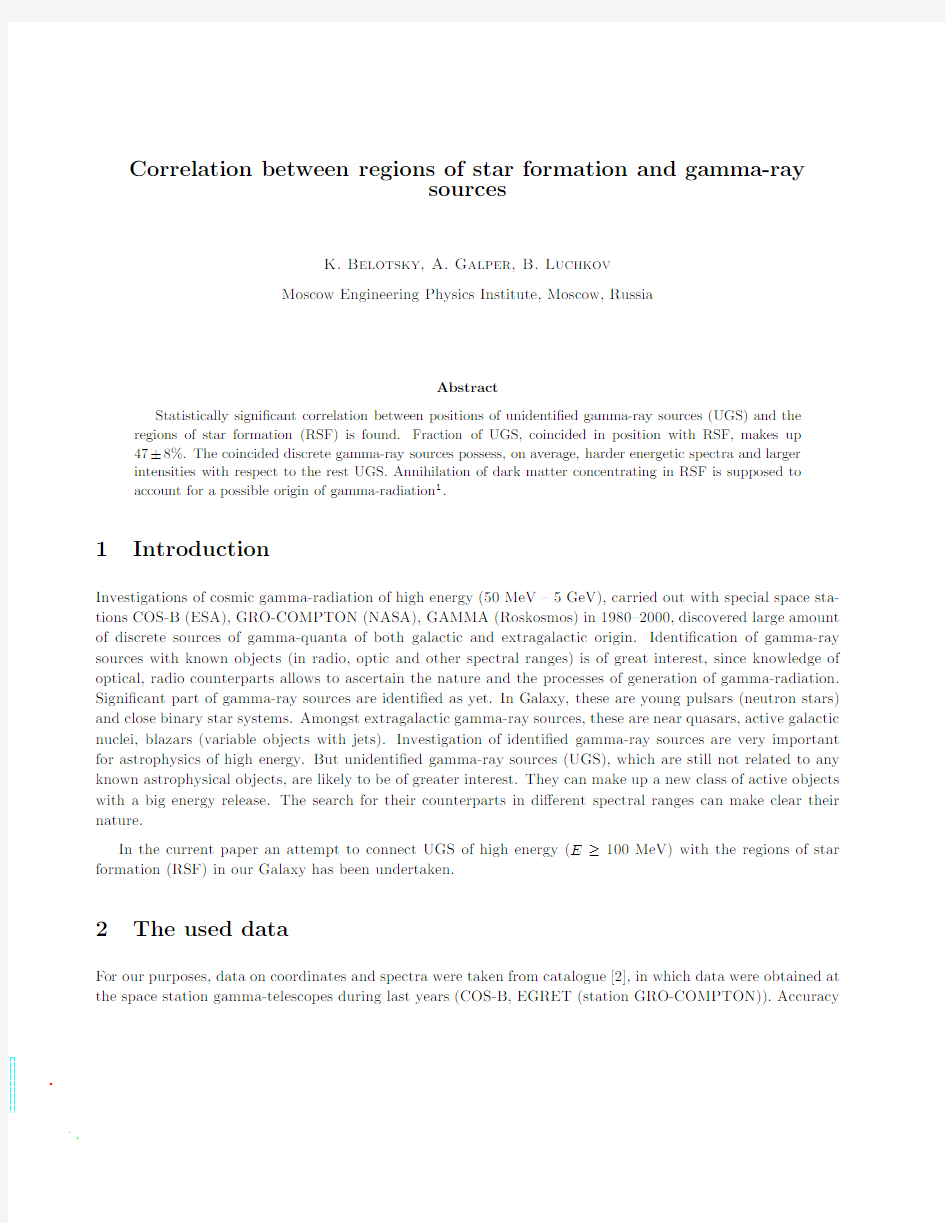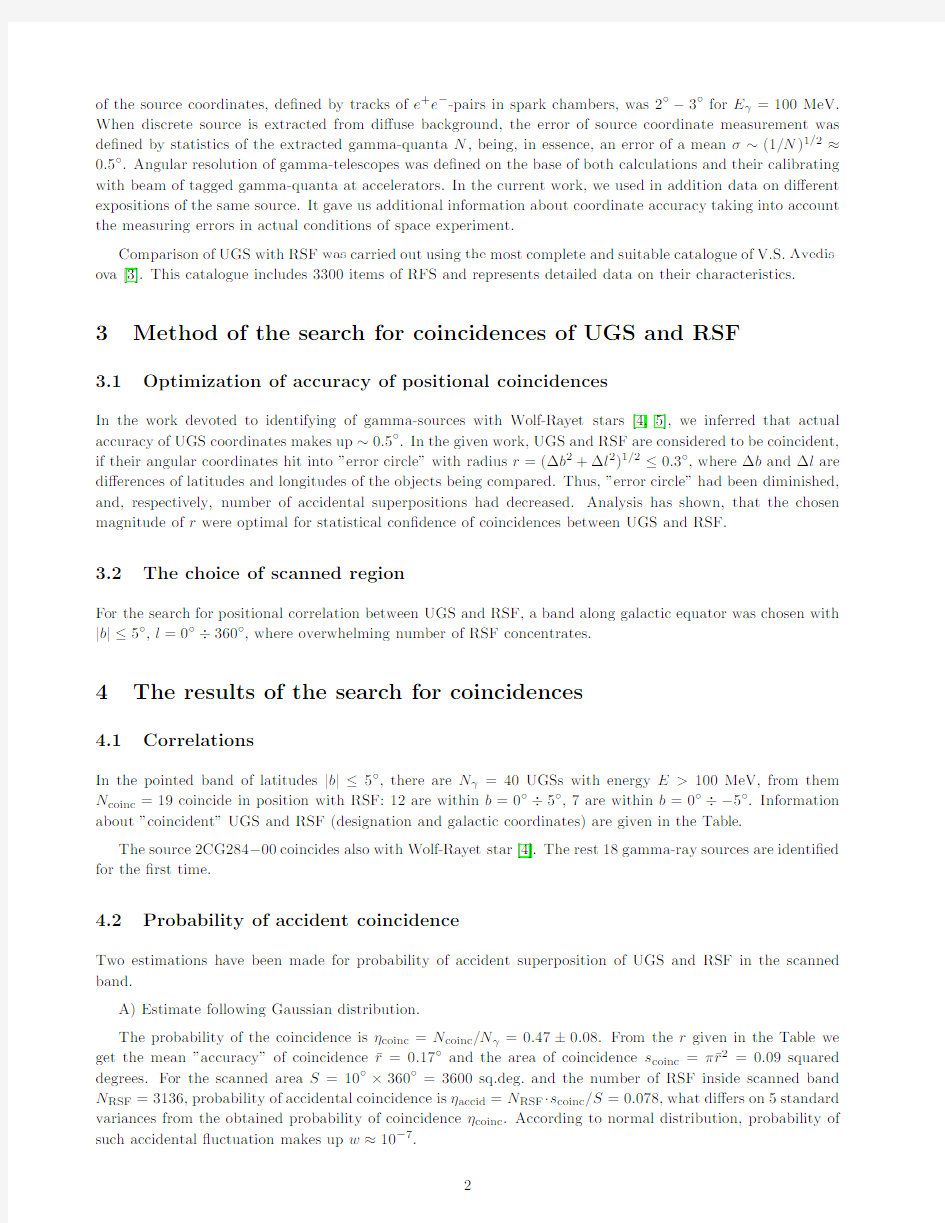Correlation between regions of star formation and gamma-ray sources


a r X i v :0804.2045v 1 [a s t r o -p h ] 14 A p r 2008
Correlation between regions of star formation and gamma-ray
sources
K.Belotsky,A.Galper,B.Luchkov Moscow Engineering Physics Institute,Moscow,Russia
Abstract
Statistically signi?cant correlation between positions of unidenti?ed gamma-ray sources (UGS)and the regions of star formation (RSF)is found.Fraction of UGS,coincided in position with RSF,makes up 47±8%.The coincided discrete gamma-ray sources possess,on average,harder energetic spectra and larger intensities with respect to the rest UGS.Annihilation of dark matter concentrating in RSF is supposed to account for a possible origin of gamma-radiation 1.
1Introduction
Investigations of cosmic gamma-radiation of high energy (50MeV –5GeV),carried out with special space sta-tions COS-B (ESA),GRO-COMPTON (NASA),GAMMA (Roskosmos)in 1980–2000,discovered large amount of discrete sources of gamma-quanta of both galactic and extragalactic origin.Identi?cation of gamma-ray sources with known objects (in radio,optic and other spectral ranges)is of great interest,since knowledge of optical,radio counterparts allows to ascertain the nature and the processes of generation of gamma-radiation.Signi?cant part of gamma-ray sources are identi?ed as yet.In Galaxy,these are young pulsars (neutron stars)and close binary star systems.Amongst extragalactic gamma-ray sources,these are near quasars,active galactic nuclei,blazars (variable objects with jets).Investigation of identi?ed gamma-ray sources are very important for astrophysics of high energy.But unidenti?ed gamma-ray sources (UGS),which are still not related to any known astrophysical objects,are likely to be of greater interest.They can make up a new class of active objects with a big energy release.The search for their counterparts in di?erent spectral ranges can make clear their nature.
In the current paper an attempt to connect UGS of high energy (E ≥100MeV)with the regions of star formation (RSF)in our Galaxy has been undertaken.
2The used data
For our purposes,data on coordinates and spectra were taken from catalogue [2],in which data were obtained at the space station gamma-telescopes during last years (COS-B,EGRET (station GRO-COMPTON)).Accuracy
of the source coordinates,de?ned by tracks of e+e?-pairs in spark chambers,was2??3?for Eγ=100MeV. When discrete source is extracted from di?use background,the error of source coordinate measurement was de?ned by statistics of the extracted gamma-quanta N,being,in essence,an error of a meanσ~(1/N)1/2≈0.5?.Angular resolution of gamma-telescopes was de?ned on the base of both calculations and their calibrating with beam of tagged gamma-quanta at accelerators.In the current work,we used in addition data on di?erent expositions of the same source.It gave us additional information about coordinate accuracy taking into account the measuring errors in actual conditions of space experiment.
Comparison of UGS with RSF was carried out using the most complete and suitable catalogue of V.S.Avedis-ova[3].This catalogue includes3300items of RFS and represents detailed data on their characteristics.
3Method of the search for coincidences of UGS and RSF
3.1Optimization of accuracy of positional coincidences
In the work devoted to identifying of gamma-sources with Wolf-Rayet stars[4,5],we inferred that actual accuracy of UGS coordinates makes up~0.5?.In the given work,UGS and RSF are considered to be coincident, if their angular coordinates hit into”error circle”with radius r=(?b2+?l2)1/2≤0.3?,where?b and?l are di?erences of latitudes and longitudes of the objects being compared.Thus,”error circle”had been diminished, and,respectively,number of accidental superpositions had decreased.Analysis has shown,that the chosen magnitude of r were optimal for statistical con?dence of coincidences between UGS and RSF.
3.2The choice of scanned region
For the search for positional correlation between UGS and RSF,a band along galactic equator was chosen with |b|≤5?,l=0?÷360?,where overwhelming number of RSF concentrates.
4The results of the search for coincidences
4.1Correlations
In the pointed band of latitudes|b|≤5?,there are Nγ=40UGSs with energy E>100MeV,from them N coinc=19coincide in position with RSF:12are within b=0?÷5?,7are within b=0?÷?5?.Information about”coincident”UGS and RSF(designation and galactic coordinates)are given in the Table.
The source2CG284?00coincides also with Wolf-Rayet star[4].The rest18gamma-ray sources are identi?ed for the?rst time.
4.2Probability of accident coincidence
Two estimations have been made for probability of accident superposition of UGS and RSF in the scanned band.
A)Estimate following Gaussian distribution.
The probability of the coincidence isηcoinc=N coinc/Nγ=0.47±0.08.From the r given in the Table we get the mean”accuracy”of coincidenceˉr=0.17?and the area of coincidence s coinc=πˉr2=0.09squared degrees.For the scanned area S=10?×360?=3600sq.deg.and the number of RSF inside scanned band N RSF=3136,probability of accidental coincidence isηaccid=N RSF·s coinc/S=0.078,what di?ers on5standard variances from the obtained probability of coincidenceηcoinc.According to normal distribution,probability of such accidental?uctuation makes up w≈10?7.
Table1:Data on coincident UGS and RSF
UGS
l b r 2CG006+00 6.68?0.25
2CG075+0075.450.73
2CG078+0178.25 2.08
2CG121+04121.18 4.02
2CG218?01218.15?0.57
2CG284?00284.24?1.13
2CG356+00356.650.13
2CG359?00359.440.01
2EGJ0618+2234189.00 3.19
2EGJ1443?6040316.16?0.49
2EGJ1718?3310353.25 2.42
2EGJ1746?28520.18?0.19
2EGJ1825?130718.30?0.39
2EGJ1857+011834.76?0.68
2EGJ2033+411280.230.80
2EGJ2227+6122106.90 3.16
2EGJ0852?4343264.250.61
2EGJ1418?6049313.450.18
2EGJ1903+052939.26?0.05
50
100
150
200
250
300
350
longitude,degree
25
5075100125150
175200n u m b e r
Figure 1:Distribution in galactic longitude of RSF (solid line)and of coincident gamma-ray sources (dashed red line).Number of coincident gamma-ray sources is multiplied by 10.
2
4
6
8
101214
flux,10-7
cm -2s
-1
2
46810n u m b e r
1.82
2.2 2.4 2.6
spectral index
1
234
56n u m b e r
Figure 2:Distribution in ?ux F (left)and in spectral index α(right)for ”coincided”(dashed red line)and ”not coincided”(solid line)UGS within band |b |≤5?
sources have greater ?uxes and harder energetic spectra,what can be regarded as a ?rst indication to peculiarity of these objects,however being not very reliable because of small statistics and large measuring errors.Nevertheless,on the base of obtained results we made one supposition about possible nature of given gamma-ray sources.It can be connected with a dark matter concentrating in RSF,annihilation of which leads to the enhanced ?ux of gamma-rays of high energy.
6Relation of RSF with dark matter
Dark matter (DM)can be supposed to concentrate in regions of forming stars.One can pick out several mecha-nisms for such concentration.Baryonic and nonbaryonic components of matter can form density inhomogeneity together (either starting from the very beginning,or having merged subsequently).In this case baryons are situated inside a clump of DM.Also,it is possible that baryonic matter,being contracted,”draws together”DM due to adiabatic mechanism of energy loss by DM in varying gravitation ?eld of baryons.Both mechanisms
are likely to be most e?ective for large inhomogeneities (with mass >~106
M ⊙)[6].In addition,density of DM should be enhanced owing to partial convergence of trajectories of DM particles to the attractive center created by baryons [7].Besides of that,DM particles,going through baryonic matter,can ”get stuck”in it and accumulate with time,e?ciency of what is dependent from respective interaction properties.In reality,
concentration of DM can come out from superposition of many mechanisms in di?erent degree,where operation of one of them provides favourable conditions for another.
Annihilation rate of DM grows as its density squared,so annihilation source shows itself in region of highest density.Amongst annihilation products,produced in the result of cascade of transitions and decays of particles, there can be gamma-quanta with energy of hundreds MeV and above.Spectrum in this case should distinguish oneself with greater hardness.
7Conclusion
The results of the undertaken search for coincidences of UGS with RSF in Galaxy point out at relation between RSF and UGS of high energy.Fraction of”coincided”UGS is big enough(47±8%),what gives the reason to consider the carried out identi?cation to be meaningful for clari?cation of UGS nature.However statistics of UGS and number of coincidences with RSF is insu?cient for decisive conclusion.
Before obtaining new observation data in forthcoming experiments(GLAST,AGILE,GALA and other)it is reasonable to carry out a detailed analysis of RSF,?rst of all with view of extraction of most massive and compact objects in the regions of star https://www.360docs.net/doc/b616746356.html,parison of them with unidenti?ed gamma-ray sources can give then more de?nite results.
8Acknowledgements
Authors are grateful to V.S.Avedisova for help in the work and analysis of results.The work is ful?lled in a framework of project of Rosobrazovanie RNP2.2.2.2.8248.
References
[1]I.V.Moskalenko,L.L.Wai,arXiv:astro-ph/0608535;Astrophys.J.659(2007),L29–L32;
arXiv:astro-ph/0702654;arXiv:0704.1324[astro-ph].M.Fairbairn,P.Scott,J.Edsjo,Phys.Rev.
D77(2008),047301;arXiv:0710.3396[astro-ph]. D.Spolyar,K.Freese,P.Gondolo,arXiv:0705.0521 [astro-ph];arXiv:0709.2369[astro-ph].K.Freese, D.Spolyar, A.Aguirre,arXiv:0802.1724[astro-ph].
Y.Ascasibar,arXiv:astro-ph/0612130.E.Vasiliev,M.Zelnikov,arXiv:0803.0002[astro-ph].
[2]D.J.Macomb and N.Gehrels,Astrophys.J.Suppl.120(1999),335.
[3]V.S.Avedisova,Astronomy Reports46(2002),N3,p.193[English translation of Russian journal:Astron.
zhurnal46,N3,p.216(2002)];V.S.Avedisova,www.strasbg.-u.fr/pub/cats.
[4]A.M.Galper,B.I.Luchkov,Astronomy Reports48(2004),N1,p.35[English translation of Russian
journal:Astron.zhurnal48(2004),N1,p.39].
[5]A.M.Galper,B.I.Luchkov,Astronomy Letters30(2004),N6,p.390[English translation of Russian
journal:Pis’ma v AZh,30(2004),N6,p.436].
[6]M.Yu.Khlopov,Cosmoparticle Physics,World Scienti?c https://www.360docs.net/doc/b616746356.html,pany,1999,596pp.
[7]K.M.Belotsky and M.Yu.Khlopov,Grav.&Cosmol.11(2005),220-222;arXiv:astro-ph/0504216.
